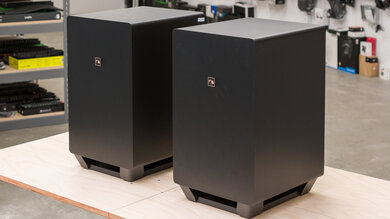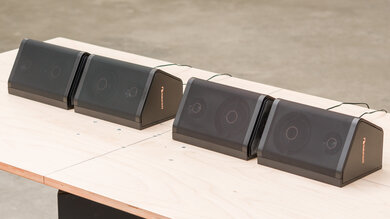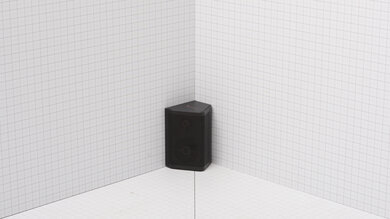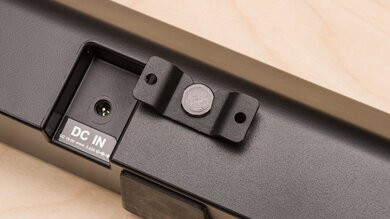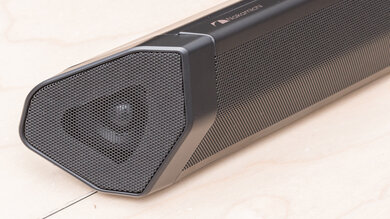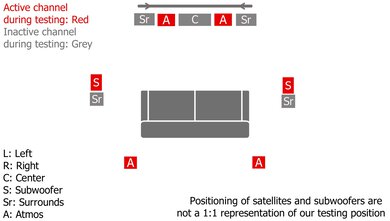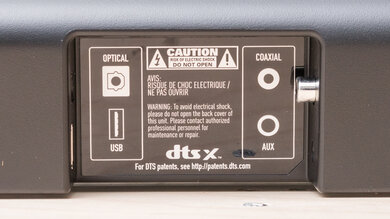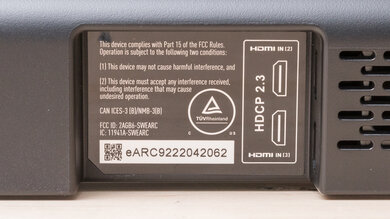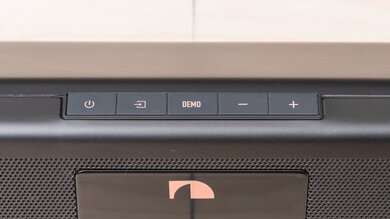The Nakamichi Shockwafe Ultra 9.2 eARC is a unique 9.2.4 Dolby Atmos setup released in 2022. Like the original Nakamichi Shockwafe Ultra 9.2Ch, it comes with two large subwoofers and four satellites to enhance your listening experience. You can place these satellites horizontally or vertically, with six different setup options to take advantage of your room. This new model comes with some extra features, including eARC connectivity for DTS:X and other immersive formats. Like the Nakamichi Shockwafe Pro 7.1 SSE, it also features the company's Spatial Surround Elevation (SSE) technology, which lets you choose between three different soundscape presets based on the size of your living room.
Our Verdict
The Nakamichi Shockwafe Ultra 9.2 eARC is very good for mixed usage. It's a unique bar, and the additional subwoofers and satellites make it a solid choice for those with larger living rooms. It gets loud, and its setup is customizable, as you can set the satellites in different configurations based on your preferences. Also, there's Dolby Atmos support, and the added eARC capability lets you enjoy other object-based and lossless formats like DTS:X. With advanced audio formats, you don't get the same immersive, all-around-you feel that makes it feel like your favorite movies are taking place in your living room.
- Gets loud.
- EQ presets.
- Dolby Atmos support.
- No graphic EQ.
The Nakamichi Shockwafe Ultra 9.2 eARC is great for dialogue-centric TV shows and podcasts. It has a discrete center channel to improve vocal clarity, and its balanced mids mean that you hear vocals clearly in the mix. You can even use its TV preset as a dialogue enhancement tool, which is nice. However, the options are fairly limited if you want to stream podcasts and audiobooks to the bar. There's Bluetooth support, but no Wi-Fi connectivity is available.
- Dialogue enhancement tool.
- Bluetooth compatible.
- No Wi-Fi, Apple AirPlay, or Google Chromecast capabilities.
The Nakamichi Shockwafe Ultra 9.2 eARC is good for music. It has very good sound quality out of the box, and its two subwoofers bring plenty of rumble in the bass range. Its overall sound is slightly bassy as a result, so you'll notice extra boom in the mix. The recessed treble leads to a lack of detail with higher-pitched instruments like cymbals. Fortunately, the bar has some customization tools, including subwoofer level and treble adjustment features.
- Gets loud.
- EQ presets.
- No graphic EQ.
The Nakamichi Shockwafe Ultra 9.2 eARC is very good for movies. This bar supports many different audio formats that you'll likely come across on different streaming platforms, from 5.1 surround sound Dolby Digital to object-based Dolby Atmos. Dialogue is pretty clear in the mix, and there's lots of rumble in the bass during action-packed scenes. However, the overall listening experience isn't quite as immersive, and sound effects seem like they're just coming from the space in front of you. You don't feel the effects happening all around you like with other premium models.
- Gets loud.
- Dolby Atmos support.
- No graphic EQ.
Changelog
- Updated Jul 14, 2025:
We've updated the Wireless Playback box to discuss the Nakamichi Shockwafe Wireless.
- Updated Dec 17, 2024:
We've updated the Sound Enhancement Features box to add a mention of the Nakamichi DRAGON.
- Updated Jan 29, 2024: Per TBU 1.3 methodology, we updated the text in the Stereo Sound boxes after retesting with the manufacturer's recommended settings. Also added text to Audio Latency: ARC, Audio Latency: HDMI In, and Audio Latency: Optical boxes. Some updates to the usages as well, in line with these changes.
- Updated Jan 29, 2024: We've converted this review to Test Bench Update 1.3. If applicable, we've retested stereo sound based on the manufacturer's recommendations. Additionally, we've expanded our audio latency tests to the following boxes: Audio Latency: ARC, Audio Latency: HDMI In, and Audio Latency: Optical. You can see the full changelog here.
Check Price
Differences Between Sizes And Variants
The Nakamichi Shockwafe Ultra 9.2 eARC is available in Black, and you can see the label for our model here.
If you come across another version of the Nakamichi Shockwafe Ultra 9.2 eARC, let us know in the discussions, and we'll update the review.
Popular Soundbar Comparisons
The Nakamichi Shockwafe Ultra 9.2 eARC is a unique 9.2.4 setup. It's one of the few bars on the market to come with two subwoofers and four satellites, which makes it ideal for those with larger living spaces like the Nakamichi Shockwafe Ultra 9.2Ch. Compared to its predecessor, it offers more tools like eARC connectivity and the Spatial Sound Elevation enhancement feature. However, its extra components aren't ideal for everyone, and other premium bars like the Bose Smart Soundbar 900 with Speakers + Bass Module and the Samsung HW-Q990A are good alternatives for those with more typical living spaces.
See also our recommendations for the best soundbars, the best Dolby Atmos soundbars, and the best soundbars with subwoofer.
The Nakamichi Shockwafe Wireless represents a few meaningful upgrades on the Nakamichi Shockwafe Ultra 9.2 eARC. Its dual sub configuration allows it to produce a much bassier sound, though both bars roll off the treble somewhat. They perform quite similarly when it comes to center channel, dynamics, and surround performance, though the Shockwafe Ultra is able to convey Atmos height effects more convincingly. That said, if you have the space to accommodate the larger Shockwafe Wireless, you'll benefit from a higher top volume and HDMI 2.1 support with the ability to passthrough 4k signals with a 120Hz refresh rate.
The Samsung HW-Q930B is better than the Nakamichi Shockwafe Ultra 9.2 eARC for most uses. These are two very different setups—the Samsung has one sub and two satellites, while the Nakamichi has two subs and four satellites. As a result, the Nakamichi is more geared towards those with large, more open living spaces. Still, it doesn't offer the same immersive listening experience as the Samsung model, especially with Dolby Atmos content. The Samsung is more customizable, too, with a more balanced sound out-of-the-box.
The Nakamichi Shockwafe Ultra 9.2 eARC is the upgraded version of the Nakamichi Shockwafe Ultra 9.2Ch. Unlike its predecessor, it has some extra features, including Dolby Vision Passthrough as well as eARC support for streaming formats like DTS:X. Its Spatial Surround Engine feature lets you choose between three different "soundscapes" based on your room's size. That said, there isn't a dramatic difference in sound quality between the two bars.
The Nakamichi Shockwafe Ultra 9.2 eARC is quite a unique bar, especially compared to the Nakamichi Shockwafe Pro 7.1 SSE. The Ultra comes with two subwoofers and four satellites, so it's ideal if you want to fill a really large space with sound. With just one subwoofer and two satellites, the Pro 7.1 SSE more closely resembles other bars on the market. That said, unlike the Ultra, it lacks eARC support for formats like DTS:X.
Test Results

Like the Nakamichi Shockwafe Ultra 9.2Ch, the Nakamichi Shockwafe Ultra 9.2 eARC comes with two subwoofers. They're mostly made of wood, and they look similar to the subs that come with the previous model.
The four satellites have a similar design to the original Nakamichi Shockwafe Ultra 9.2Ch. They're made of plastic with a metal grille in front. You can place them horizontally or vertically, depending on your preferences.
The Nakamichi Shockwafe Ultra 9.2 eARC has satellites that aren't very large, and you can place them horizontally or vertically to meet your needs. However, there are four of them, and they have to be wired to the sub to work, which adds some extra cables to your room.
The Nakamichi Shockwafe Ultra 9.2 eARC has a good stereo frequency response. With two subwoofers, it brings plenty of thump and rumble in the low-bass for genres like EDM and hip-hop. The extra emphasis in the bass range muddies vocals and lead instruments a bit, and the roll-off in the treble means that the audio lacks some detail and brightness. You can always switch up the bar's sound settings for a different sound. We tested with the manufacturer's recommended sound settings (with all channels turned on, the room size set to Medium, and Spatial Sound Elevation set to 1) and placed the satellites and the subwoofers beside and behind the sofa based on their recommendations.
If you prefer a more even sound with stereo content, set the subwoofer level to 5 and the treble to 9. The resulting sound is more neutral, with more detail in the treble range. The bass still has some boominess, but we found that reducing the subwoofer level didn't provide adequate thump and rumble.
The Nakamichi Shockwafe Ultra 9.2 eARC has a good stereo soundstage. It has very good focus, so you can pinpoint vocals and instruments to exact locations in the soundstage around you. The soundstage itself is perceived to be about the size of the bar, which is good. If you want it to seem wider, you can activate all of the bar's channels. There isn't much difference in the focus with all the channels active, although if you pay close attention, it seems slightly more diffused.
The Nakamichi Shockwafe Ultra 9.2 eARC has excellent stereo dynamics. The bar gets loud, so you don't have any trouble filling large and open spaces with sound. It doesn't get as loud as its advertised 113dB SPL, but unless you like a loud sound, this won't be an issue. There's not much compression, either, so you can crank up the volume without affecting the clarity of your audio.
The Nakamichi Shockwafe Ultra 9.2 eARC has a great center channel performance. Its discrete center channel enhances overall vocal clarity. The frequency response for this channel is very balanced, especially in the mids, where most voices reproduce. As a result, you don't have any issues following the action on screen.
Note:The center channel was tested in Native mode with the surrounds on. It was also set to the Music EQ.
The Nakamichi Shockwafe Ultra 9.2 eARC comes with four discrete satellite speakers, so it offers a more clear and real representation of sound effects in the space around you when compared to bars without satellites. Out-of-the-box, the frequency response of these channels is dark and boomy, with lots of extra punch in the bass and a lack of detail in the treble range. You find that sound effects are overpowered with all the additional rumble in the mix. Fortunately, you can switch up its performance with its customization tools, so you can get a better performance overall.
Note:The surround channels were tested in Native mode with the surrounds on. The bar was also set to the Music EQ.
The Nakamichi Shockwafe Ultra 9.2 eARC supports Dolby Atmos content. It uses front-firing drivers in the bar as well as up-firing drivers on its satellites to ricochet sound off the ceiling, which creates the illusion of height in the space around you. As with its surround channels, the frequency response is quite dark and boomy out-of-the-box due to the recessed treble and emphasized bass. Sound effects aren't as clear as a result, and the bass overpowers other details in the mix. With its customization tools, you can get a much more balanced frequency response to improve the sound if you wish (which would also improve its score for this test).
Subjectively, the bar does an okay job simulating an Atmos soundstage. Most of the sound effects are concentrated towards the front of the room, so you don't get the same immersive feelings as more premium models, and sound doesn't extend around you or behind you. Compared to the Nakamichi Shockwafe Ultra 9.2Ch, the bar doesn't produce Atmos audio from its side-firing drivers, which explains some of the difference in performance.
Atmos content was tested in Dolby Surround mode, with Surround turned on. The Spatial Surround Elevation was set to 2, and the Music EQ was on.
The Nakamichi Shockwafe Ultra 9.2 eARC has several sound enhancement features on hand. Unfortunately, compared to other premium bars, there's no dedicated room correction feature with a microphone to measure your room's acoustics and adjust the sound accordingly. Instead, it has a 'Room' button that lets you choose between three preset acoustic environments: 'Small,' 'Medium,' and 'Large.' That said, you can still adjust its sound a bit to make up for this, thanks to its treble adjustment as well as its EQ presets, Music, Movie, Game, News, Sports, and DSP Off. The News preset doubles as a dialogue enhancement tool. Also, the 'Bass' button on the remote lets you control the subwoofer level. There's no On Screen Display (OSD) function for deep customization options like you get with the Nakamichi DRAGON, though.
The Nakamichi Shockwafe Ultra 9.2 eARC connects to your TV over Optical or HDMI connections. With three HDMI In ports, you can connect the bar to multiple devices and use it for high-quality passthrough. There's also a Coaxial input for older devices, as well as a USB port for firmware updates.
The Nakamichi Shockwafe Ultra 9.2 eARC has incredible audio format support via ARC. It supports lots of different formats, including 5.1 surround sound like Dolby Digital, as well as lossless and object-based formats like Dolby Atmos. Unlike the Nakamichi Shockwafe Ultra 9.2, it supports eARC, too.
The Nakamichi Shockwafe Ultra 9.2 eARC has outstanding audio support via HDMI In. It supports lots of different formats, so you don't have issues watching content on streaming platforms and Blu-rays.
The Nakamichi Shockwafe Ultra 9.2 eARC supports both Dolby Digital and DTS over Optical. Dolby Digital is most commonly found on streaming platforms, while you're most likely to run into DTS content on Blu-rays.
Over an ARC connection, this soundbar is suitable for watching videos and movies. With low latency, you don't notice a delay between the audio you hear and the visuals on screen with common surround sound formats like Dolby Digital as well as lossless and object-based formats like Dolby Atmos. We performed these tests with the manufacturer's recommended sound settings, but it's worth noting that if you turn DPS off, latency lowers by about 20 to 30 ms. Also, some apps and TVs compensate for latency differently.
You can also obtain lower latency values over HDMI In by turning DPS off. However, you may find that you don't need to do that in the first place, given the bar's low latency with a wide array of commonly found audio formats. Depending on the app or the TV you use, latency may vary slightly, though.
Over an Optical connection, latency falls within good limits with 2.0 PCM content. It's a bit higher with Dolby Digital, though, so you'll notice some lip-synching errors. Fortunately, this bar has a Lip Sync feature that lets you manually adjust the delay to improve the performance. Some apps and TVs may compensate for latency differently, too.
The Nakamichi Shockwafe Ultra 9.2 eARC can passthrough some of the highest-quality bandwidth signals, including Dolby Vision Passthrough. When you connect the bar between two devices, like a TV and a PC, text on your screen is clear and crisp. It can't passthrough 4k @ 120Hz, though.
The Nakamichi Shockwafe Ultra 9.2 eARC lets you wirelessly stream audio from your mobile devices to the bar via Bluetooth. While Nakamichi bars generally lack other wireless connectivity options, you can opt for the Apple AirPlay-compatible Nakamichi Shockwafe Wireless if integration with Apple devices is important to you.


